V1412 Aql: a simulation
Michel Bonnardeau
First version 24 Aug 2009
Updated 2 Sep 2009 (more observations)
Updated and corrected 3 Sep 2009 (more observations; uncertainties on
the ToM of the 2 eclipses taken into account at the suggestion of Wolfgang
Renz; correction of the number of solutions)
Updated 5 Sep 2009 (more observations; simulation with the period down to 1 d;
inclination)
Corrected 10 sep 2009 (uncertainties on the ToM of the 2 eclipses)
Abstract
A Monte Carlo simulation which may be useful to search for eclipses is proposed.
Introduction
The white dwarf G29-4 (or V1412 Aql) was observed to be unexpectedly faint on 2 occasions, in 1985 and 1988. This is interpreted as eclipses due to a dark, substellar companion (Zuckerman & Becklin (1988)).
Feb 2009, the AAVSO lauched a campaign to observed this object to detect its eclipses (AAVSO Special Notice #148).
I propose here a Monte Carlo simulation which may be useful to speed up the discovery of eclipses.
Observations
The 2 observed eclipses are:
19851007.11 (Landolt (1985)), heliocentric correction 180.56s, t85=2,446,345.612
HJD. The uncertainty is taken as et85=0.005 HJD;
19880715.3 (Carilli & Conner (1988)), heliocentric correction 441.74s,
t88=2,447,357.805 HJD. The uncertainty is taken as et88=0.05 HJD.
The AAVSO has 600 negative (i.e. no eclipse) observations on 1 Sep 2009.
Arne Henden obtained 14 time-series showing no eclipses, from 30 Oct to
8 Dec 2008, total duration 34.1 h. And also 7 short time-series, in 2002
and 2008, total duration 2.6h.
Robert Fridrich obtained a time-series on 1 sep 2009, duration 0.3 h.
Simulation
The orbital period is P=(t88-t85)/n=(1012.193 days)/n where n is an
integer.
G29-4 is a white dwarf, so it has a small size (about that of Earth),
then the eclipse duration tau is given mostly by the diameter D of the
occulting body:

with M the mass of the system, G the gravitational constant (taking for
the inclination i=90° and for the eccentricity e=0).
The computer simulation is a Monte Carlo one where a large number of random sets of n, M, D are used to derived ephemeris. The ephemeris that are retained are those that give the 2 observed eclipses and that do not give eclipses for the negative AAVSO observations.
The algorithm works the following way:
The spectra
of n, M and D solutions are:
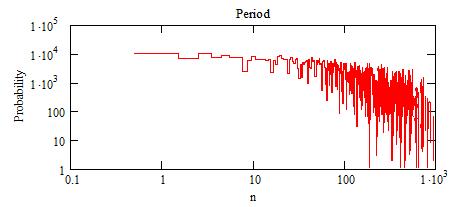
The "probability" is actually the number of acceptable solutions from
the simulation.
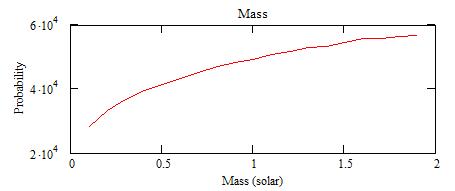

The probability for the eclipse duration:
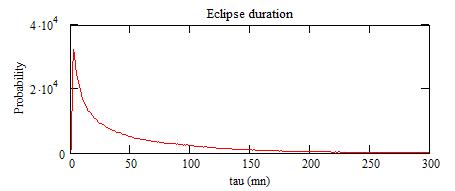
and the period:
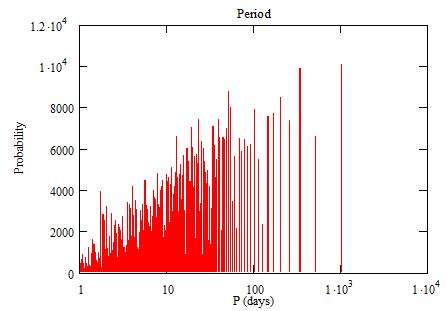
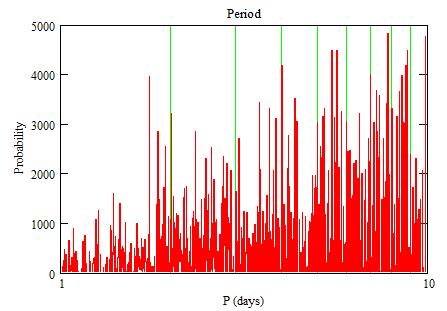
The probability for future eclipses may be computed:
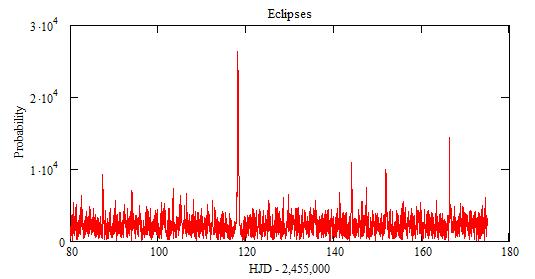
However, the uncertainties
et85 and et88 introduce an incertainty on their timing of (where t is
the current time):
dt = et85+(et85+et88)*(t-t85)/(t88-t85)
dt = 0.48 day
Close-up:
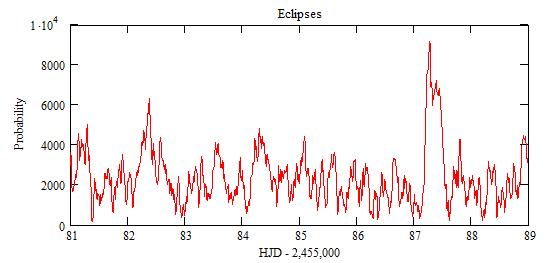
The small peaks correspond to n between 10 and 30. There is an incertainty
of dt=0.48 on their position.
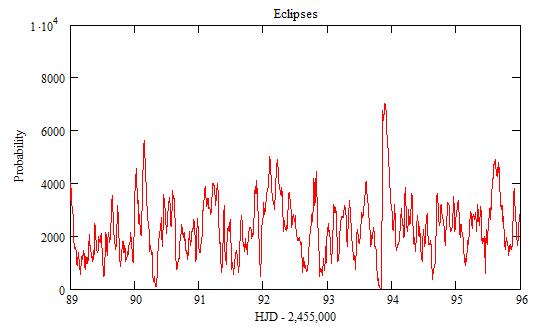

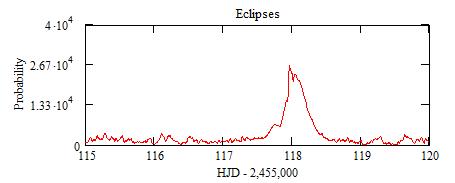
This large peak around 118 (12 Oct 2009) +/-dt=0.48 comes from values
of n that are multiple of 3.
Other large periods:
n=1 and n=2: 455 THJD (15 Sep 2010)
n=4: 202 THJD (5 Jan 2010)
n=5: 253 THJD (25 Feb 2010)
n=7: 166 THJD (30 Nov 2009)
n=13: 143 THJD (8 Nov 2009)
Discussion
The minimum inclination of the orbit (so as to have an eclipse) may be estimated as:

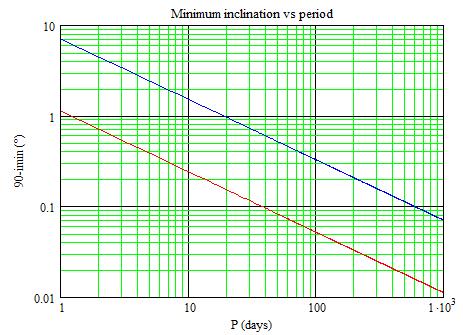
Red line: for D=1 and M=2; Blue line: for D=5 and M=1.
Long periods require an inclination of almost exactly 90° which would
be a somewhat improbable coincidence.
References
Carilli C., Conner S. (1988) IAU Circ. 4648.
Landolt A.U. (1985) IAU Circ. 4125.
Zuckerman B., Becklin E. (1988) IAU Circ. 4652.
|
|
|||
|
|||
|
|
|||
|
|
|||
|
|||
